
|
|

March 9, 2007
The Big Trip 2006, Part V: Portland's West Hills
 Once
every year or so, when finances and schedules permit, your editor
and a couple of his similarly-obsessed radio pals get together
to spend a week or so exploring a corner of our great nation,
packing our schedules as full as possible to visit as many interesting
broadcast facilities as we can.
Once
every year or so, when finances and schedules permit, your editor
and a couple of his similarly-obsessed radio pals get together
to spend a week or so exploring a corner of our great nation,
packing our schedules as full as possible to visit as many interesting
broadcast facilities as we can.
And then, a few months later, once we've caught our breath (and some much-needed sleep), we share it all with you here on Tower Site of the Week (and in audio form over on Tophour.com) in a feature we call "The Big Trip."
The 2006 version of the Big Trip began and ended in Seattle, and along the way took us as far south as Eugene, Oregon and as far east as Coeur d'Alene, Idaho.
Day Four - Sunday, September 24
After a relaxing morning drive down the Oregon coast from Astoria to Tillamook, our little group turned inland, heading east on Oregon 6 to US 26, the Sunset Freeway that passes through Portland's western suburbs on its way into downtown Portland.
 That's
the interchange between US 26 and I-405 on the west side of downtown,
above, and do make a note of that pointy skyscraper called the
"KOIN Center," because we'll get a closer look at it
in our next installment.
That's
the interchange between US 26 and I-405 on the west side of downtown,
above, and do make a note of that pointy skyscraper called the
"KOIN Center," because we'll get a closer look at it
in our next installment.
Before we get downtown, though, we make a quick studio stop west of town in an office park in Beaverton (home of Nike, among other cornerstones of Portland's economy) to check out the newish studio building that's home to Meredith's Fox affiliate, KPTV (Channel 12) and its My Network TV outlet, KPDX (Channel 49).
As new as this studio building is (circa 2000), there's lots of history behind this station pairing, and we'll be coming back to it a few times during our extended look at Portland's broadcast scene.
Our destination this warm afternoon is the studio building of Entercom Portland, tucked in between I-5 and the Willamette River south of downtown.
(The street address here is "0700 SW Bancroft," and that leading zero, confusing though it is to most computerized mapping programs, is significant, since it indicates the part of Bancroft east of I-5, which we finally figured out after some confused driving on the part of Bancroft west of I-5.)
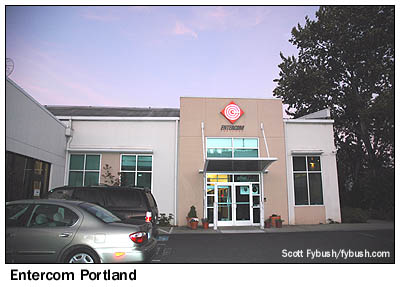
|
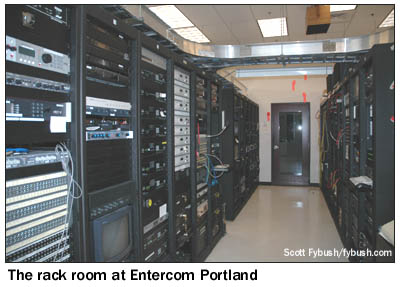
|

 We're
jumping back in time a bit here, actually - that particular bit
of confused driving took place Friday night, when we made our
first stop here en route from Eugene to Seaside. It was then
that we had a tour of the studios with Kent Randles, K7YXZ, senior
engineer at Entercom Portland.
We're
jumping back in time a bit here, actually - that particular bit
of confused driving took place Friday night, when we made our
first stop here en route from Eugene to Seaside. It was then
that we had a tour of the studios with Kent Randles, K7YXZ, senior
engineer at Entercom Portland.
This facility has grown over the years as Entercom has added more stations here, and when we visit in September, the L-shaped studio cluster just past the lobby is home to oldies KKSN (910 Vancouver WA)/KSLM (1390 Salem), sports KFXX (1080), rock KGON (92.3), modern rock KNRK (94.7 Camas WA), adult hits "Charlie" KYCH (97.1), country "Wolf" KWJJ (99.5) and hot AC "Buzz" KRSK (105.1 Molalla), all nicely denoted by banners over their respective studios and production rooms. (KKSN would subsequently be sold off, but we'll tell that story in more detail when we get out to its transmitter later on this visit.)
As we left the studios on Friday night, we looked west across I-5 up to one of the more distinctive profiles to be seen on any hilltop in America: the unique silhouette of the self-supporting tower known locally as "Stonehenge." (So named, incidentally, on the theory that when its ruins are discovered a thousand years from now, it'll prove just as perplexing as its namesake.)
And when we regroup with Kent in the Entercom parking lot Sunday afternoon, Stonehenge is our first destination on a busy afternoon of Portland tower-hunting. As we drive the winding roads up through wealthy residential neighborhoods to the tower, we learn some of the history that led to this unusual 600' tower being here:
The land where the tower now sits, 1000 feet above sea level, is just shy of being the highest point in Portland city limits, and so this area (Healy Heights-Council Crest) was a natural spot for siting transmitter facilities, especially as FM and TV came on the air in Portland beginning in the forties. The site where the Stonehenge tower now sits began as the studio and transmitter site of an independent FM station, KPFM (94.9, later 97.1), in 1946. KPFM added an AM station, KPAM (1410) at the site in 1951, and in 1955 a new tower went up on the site for KLOR-TV, channel 12. KLOR became KPTV in 1957 (we'll dissect the whole strange history of channels 27 and 12 next week), and channel 12 moved up to Skyline Drive in 1965.
The next lot north of the KPAM/Stonehenge site, at 4636 SW Council Crest Drive, was home to one of Portland's first FM stations, KPRA (99.5). Another site a block away, at 4545 SW Council Crest, was the home of the original KGW-FM (100.3, later sold away from the AM and eventually becoming KQFM and later KKRZ). That site was eventually donated to public broadcasting and became the first home of public TV station KOAP-TV (Channel 10) and its FM outlet on 91.5, which started life at 92.3 as KEX-FM on yet another nearby tower over on Carl Drive.
And the tower in the middle of Council Crest Park, less than a mile to the north of Stonehenge, was home in 1952 to the first commercial UHF station in America (and Portland's first TV station of any kind), KPTV (Channel 27).
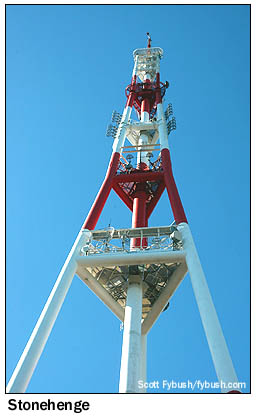
|

|
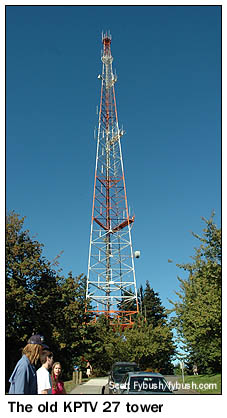
|
By the eighties, this area was a jumble of aging towers. The KPRA site had gone through several owners, briefly becoming home to another incarnation of channel 27, KHTV, in 1959 (don't worry - we'll come back to the whole KPTV/Channel 27 saga later in our Portland history, I promise!), and then to KGMG, later KXL-FM (95.5), as well as KBOO (90.7), KGON (92.3), KPDQ-FM (93.7), KWJJ-FM (99.5) and KKRZ (100.3). The future Stonehenge site remained home to 1410 and 97.1, by then KKSN and KKSN-FM - and all the stations up there were operating from fairly low antennas that produced lots of RF complaints from the (increasingly affluent) neighbors.
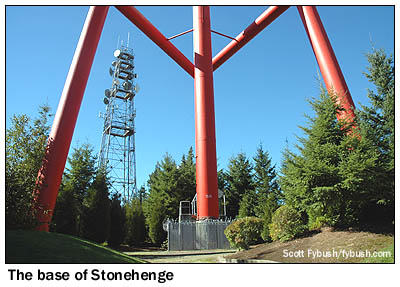
|
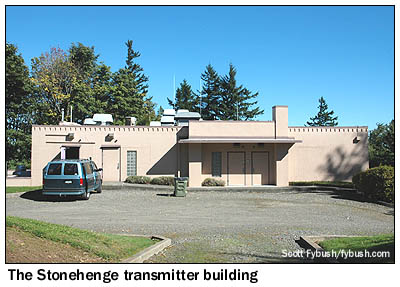
|
Those neighbors, predictably enough, complained loudly and passionately when KGON proposed building a new 600-foot tower on the property it planned to buy from KKSN, but for once good sense prevailed. The new "KGON Tower" became a community facility designed to consolidate many of the smaller towers in the area, with a master antenna up high enough to alleviate some of the RF issues at ground level. (The AM on 1410, by the way, ended up diplexing on the Oaks Park tower down by the Willamette River, the history of which we'll discuss in next week's installment.)
Engineer Gray Frierson Haertig was the project engineer for the $9 million reconstruction job, and he created one of the classier multi-user facilities we've seen in our travels. The old KPAM studio building was gutted and rebuilt with space for multiple FM tenants - and painted a nice shade of purple, too. Entering through the door on the left, there's a small office and bathroom leading to the KGON transmitter (hey, it was their site) and into the big area (on the right, as seen from the parking lot) that's home to the Shively combiner.

|
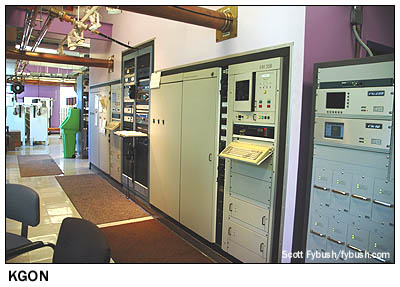
|
Even the combiner here is a little unusual. It was designed for the original five stations on the site: KBOO (90.7), KGON (92.3), KPDQ-FM (then on 93.7, now on 93.9), KKSN (97.1, now KYCH) and KWJJ (99.5), and was subsequently expanded to include later additions KFIS (104.1 Scappoose) and KXJM (95.5, the former KXL-FM). By the time an eighth station, KTRO (93.1 Gladstone) was added into the system in early 2006, the combiner had been redesigned so that the three low-powered stations (90.7, 93.1 and 104.1) were "branch" combined with the five high-powered signals. (The branch combiners are off to the left of the photo above.)
By the time the combiner's done doing its thing, there's a 9" rigid line carrying some 170 kW of RF down into the basement - and we're on our way to see where it goes, after a quick peek into those other doors off the parking lot to see the transmitters inside. KFIS (Salem's contemporary Christian "Fish") is in a little room behind the office, inside. The outside rooms are home to KBOO (a nifty community radio station that was an offshoot of Seattle's legendary KRAB) and to Salem's other stations - KPDQ-FM and its newest addition, KTRO, which is the relocated and downgraded version of what was once KAST-FM (92.9) over in Astoria. See those two little teeny Nautel transmitters at the top of the center racks, below? That's KTRO.

|
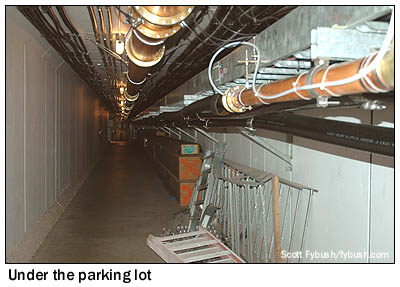
|
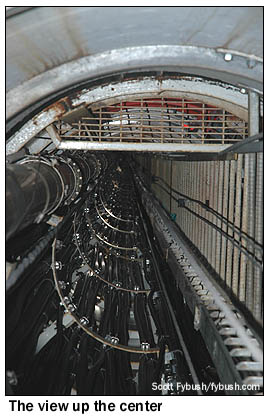 The
ground slopes down sharply towards the back of the building (which
has a million-dollar view over the city and out to Mount Hood),
where several doors lead into basement rooms that are home to
KYCH, KWJJ, a huge generator and a common room with row upon
row of paging and other commercial radio services. A room off
that is home to KNRK - and in the back, there's a door that leads
into a tunnel under the parking lot.
The
ground slopes down sharply towards the back of the building (which
has a million-dollar view over the city and out to Mount Hood),
where several doors lead into basement rooms that are home to
KYCH, KWJJ, a huge generator and a common room with row upon
row of paging and other commercial radio services. A room off
that is home to KNRK - and in the back, there's a door that leads
into a tunnel under the parking lot.
How classy is this site? So classy that there's not an inch of exposed transmission line outside, or even visible on the tower.
 It
all goes underground and up the fat center tube of the tower
to the various antennas, including the Jampro helical FM master
antenna, the Shively 6810 at the very top that KNRK uses (it's
directional, so it can't be part of the master antenna), and
the various backup antennas each station maintains on the legs
of the tower. I'm told - and will take it on faith, thank you
very much - that it's about a 550-foot climb up the center tube
to the platform at the top of the tower, beneath the Jampro.
(There were plans for an elevator up one of the side legs of
the tower, and even some talk of an observation deck, but that
never materialized.)
It
all goes underground and up the fat center tube of the tower
to the various antennas, including the Jampro helical FM master
antenna, the Shively 6810 at the very top that KNRK uses (it's
directional, so it can't be part of the master antenna), and
the various backup antennas each station maintains on the legs
of the tower. I'm told - and will take it on faith, thank you
very much - that it's about a 550-foot climb up the center tube
to the platform at the top of the tower, beneath the Jampro.
(There were plans for an elevator up one of the side legs of
the tower, and even some talk of an observation deck, but that
never materialized.)
By the way, the outer legs of the 500-foot tower are filled with concrete up to the 400-foot level. This tower isn't going anywhere, no matter how much shaking goes on up here.
 One
more loose end to tie up before we head out of Stonehenge to
more of the west side's notable TV and FM sites: the old KXL-FM
building adjoining Stonehenge to the north ended up being sold
to Gray Haertig, who took down the tower, built a triangular
deck on its insulators, and renovated it into a classy rental
property, complete with a repurposed "on air" light
over the front door for the street number. (Gray also owns the
other home on the site, which he's renovating for himself; you
can see many more of his pictures of these sites at a page on
Don
Mussell's excellent site.)
One
more loose end to tie up before we head out of Stonehenge to
more of the west side's notable TV and FM sites: the old KXL-FM
building adjoining Stonehenge to the north ended up being sold
to Gray Haertig, who took down the tower, built a triangular
deck on its insulators, and renovated it into a classy rental
property, complete with a repurposed "on air" light
over the front door for the street number. (Gray also owns the
other home on the site, which he's renovating for himself; you
can see many more of his pictures of these sites at a page on
Don
Mussell's excellent site.)
After a stop at the Council Crest Park tower, which is now used for the city's public safety communications, we move north across US 26 to Skyline Drive, home to most of the rest of Portland's FM and TV dial.
The first site up here, known today as "Sylvan," was built in the 1930s for KOIN (940, later 970), with two 545' Ideco towers for the directional AM signal. (One of those towers still stands, and the other was rebuilt after a storm destroyed it in the early sixties; the AM station is now KCMD, "Solid State 970," with hot talk.)
When KOIN-TV (Channel 6) came along as Portland's first VHF station in 1953, it came up here as well, building a 700-foot tower that was supplanted by a 1000-foot tower in 1963. Those towers both came down in a 1971 storm, at which point KOIN built a 222-foot temporary tower (still here as an aux), then a new 1000-footer. It was joined by another 1000-footer in 1999 for community DTV use - not only KOIN-DT (Channel 40) but also KATU-DT (Channel 43, ABC), KRCW-DT (Channel 33, CW) and TBN's - er, National Minority Television's - KNMT (Channel 24) and KNMT-DT (Channel 45). There's lots of FM up here, too - CBS Radio's KUPL (98.7), KUFO (101.1), KINK (101.9), KLTH (106.7 Lake Oswego) and KVMX (107.5 Banks), plus three noncoms, Catholic KBVM (88.3), jazz KMHD (89.1 Gresham) and classical KBPS-FM (89.9).
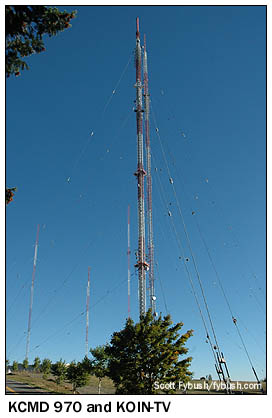
|
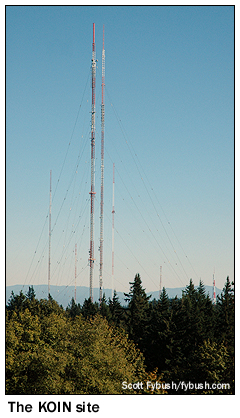
|
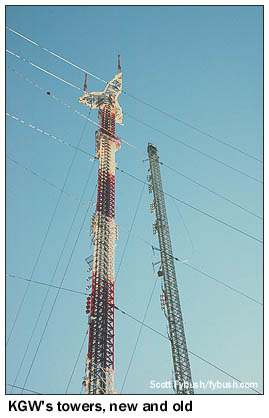
|
The Sylvan site was soon joined by a new cluster of towers just to the northwest. In 1956, King Broadcasting put KGW-TV (Channel 8) on the air from what's now known as the "Skyline site." Its tower fell in the same 1962 storm that downed one of KOIN radio's towers over at Sylvan, but was soon rebuilt. That's the tower seen at right, now in a fetching shade of dark green in its new, shortened role as an auxiliary tower to the big new 925-footer that went up in 2000, as this site took on a new role as another major master-antenna facility.
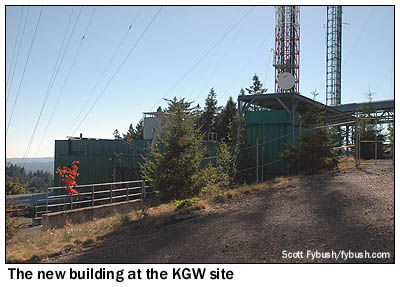
|
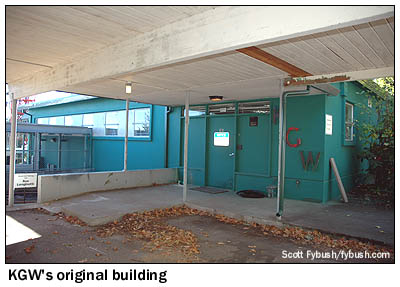
|
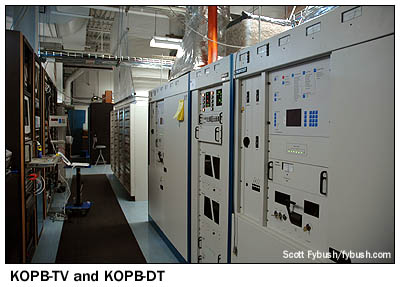 The
original 1956 KGW building (also painted dark green) was joined
by a big
new two-story building next door, home to Clear Channel's
KKRZ (100.3), KKCW (103.3 Beaverton) and KIJZ (105.9 Vancouver
WA), as well as Entercom's KRSK, downstairs, and to Oregon Public
Broadcasting's KOPB-TV (Channel 10/DT 27) and KOPB-FM (91.5)
upstairs. (Channel 10 had migrated to the KPDX-TV tower after
leaving Healy Heights and before coming here; the old Healy Heights
site remains in use as a microwave relay hop between the OPB
studios and Skyline.)
The
original 1956 KGW building (also painted dark green) was joined
by a big
new two-story building next door, home to Clear Channel's
KKRZ (100.3), KKCW (103.3 Beaverton) and KIJZ (105.9 Vancouver
WA), as well as Entercom's KRSK, downstairs, and to Oregon Public
Broadcasting's KOPB-TV (Channel 10/DT 27) and KOPB-FM (91.5)
upstairs. (Channel 10 had migrated to the KPDX-TV tower after
leaving Healy Heights and before coming here; the old Healy Heights
site remains in use as a microwave relay hop between the OPB
studios and Skyline.)
The combiner here is also a Shively, as is the 8-bay panel antenna mounted at the 720-foot level of the fat new tower, which has a three-armed platform at the top, with only two arms occupied - one by the stacked antennas for KOPB-TV/DT and the other for the stacked antennas of KGW-TV and KGW-DT (Channel 46).
(This site, it should be noted, was the longtime home of KINK 101.9, KGW's second venture into FM beginning in 1968, before it ended up in the hands of CBS Radio and joined its new sister stations over at Sylvan a few years back.)
From here, we can see the three other tall towers in the Skyline farm: to the west, sister stations KPTV (Channel 12/DT 30) and, beyond that, KPDX (Channel 49/DT 48), and just to the southeast, the tower of ABC affiliate KATU (Channel 2). KATU's digital signal is on the air from KOIN's Sylvan Tower, and it's not clear (to us, anyway) what becomes of its analog tower after the DTV conversion in 2009.
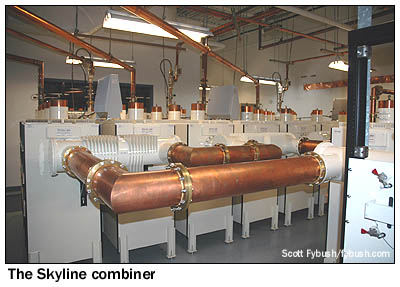
|
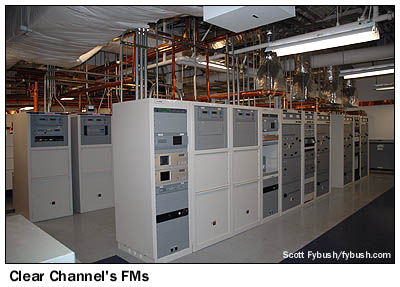
|
What is clear to us is that there are still plenty more Portland sites to see before our day is done. Join us right back here for our next installment, in which we see many of the studios of downtown Portland, plus some AM towers, not to mention one of America's finest independent bookstores - and visit Tophour.com beginning Wednesday, March 14 to hear the legal IDs of greater Portland!
 The
Tower Site Calendar 2007 is here! They're about to sell out,
just like 2006 did - order today at the Fybush.com
Store!
The
Tower Site Calendar 2007 is here! They're about to sell out,
just like 2006 did - order today at the Fybush.com
Store!
- Previous Site of the Week: Astoria, Seaside and Tillamook, Oregon
- Next Week: Portland, Oregon (part one)
- Site of the Week INDEX!
- How can you help support Site of the Week? Click here!
- Submit your suggestions for a future Site of the Week!
